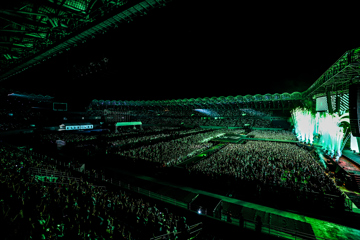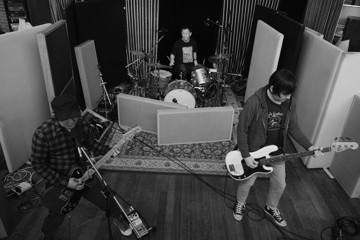Could 'Spider-Man: Into The Spider-Verse' Be The One To Save The Comic Book Film Genre?
"'Spider-Man: Into The Spider-Verse' is, in such, such a blast that you wish more comic book movies were like it, and like actual comic books."
SPIDER-MAN: INTO THE SPIDER-VERSE
★★★★
Spider-Man: Into The Spider-verse throws down an almighty gauntlet. This animated ‘alternate’ Spider-Man story is so fun, funny, brilliantly-stylised, artfully-executed, deliriously meta-, absurdistly-mounted, winkingly referential, and gloriously lurid that it makes you consider the whole comic book movie machine anew. When an animated film like this so captures the spirit of comic books, why, then, do we bother with all the live-action films, where green-screen’d actors are marooned in the assembled pixels of CGI landscapes that look, largely, pretty garbage?
The answer, ideally, is that we shouldn’t. Just scrap the whole thing. Cancel the MCU, and burn the DCEU in the fires of hell. Having recently reached a state of deeply existential superhero movie fatigue watching Venom, I’d be happy to never sit through another live-action comic book flick. Especially when this animated tentpole pic is such a joy.
Much of that joy starts at the top, where the project was developed by Phil Lord and Christopher Miller, AKA the dudes behind The Lego Movie and the Jump Street films, and, yes, the guys who were fired mid-Solo. It’s no surprise, then, that Spider-Man: Into The Spider-verse is way meta-, beginning with the fact that its premise —Spider-people from various alternate dimensions and times come together — is gleefully playing with the most-basic notions of the modern-day blockbuster: world-building, extended universes, team-up movies.
The great stylistic approach of the movie — which is directed by Bob Persichetti, Peter Ramsey, and Rodney Rothman — is to riff on the familiar visuals of comic art: from text boxes, speech bubbles, and ‘bam’/‘boom’/‘zap’ blotches; to lawn drawings and pencil shadings, split panels and frame within frames; to, even, dot colour and double-printing and slightly-off overlays. For those who ardently believe in comic visuals as legit artform, here you see the genre’s shades of fauvism, pointillism, pop-art; colours bright, figures popping, imagery distinctive. There’s none of the deathless ambience of CGI-backdrops’ uncanny valley: computer animation is employed, but the effect is, always, gloriously 2D.
Don't miss a beat with our FREE daily newsletter
When each of the alternate-universe Spider-Men tell their introductory backstory, they blithely barrel through origin-mongering with a batty briskness that recalls Edgar Wright’s astonishing work with comically-swift transition. These moments are also where the general comic book vibes get their most overt: montage mounted by having the images ‘flipped through’, like the pages of a comic.
Whilst Shameik Moore’s central Spider-teen is the familiar telling of this tale — the freshly-bit kid trying to balance high school with newfound super-powers — each successive Spider-character gets wackier: Jake Johnson voices a washed-up, out-of-shape Peter Parker; Kimiko Glenn a spider-mecha-piloting animé girl; Nicolas motherfuckin’ Cage a black-and-white-shaded, dramatically-lit, hardbitten-noir Spider-gumshoe; and John Mulaney voicing a Looney cartoon Spider-pig who drops anvils and wields a giant wooden hammer and makes you feel like you’re both watching an old WB cartoon and/or Big Mouth (the voice cast also includes Brian Tyree Henry, Mahershala Ali, Zoë Kravitz, Hailee Steinfeld, Lily Tomlin, Lake Bell, Kathryn Hahn, Liev Schreiber, Chris Pine, and Oscar Isaac; making it more loaded than an Avengers movie).
Whilst there’s emotional beats — ahoy, deathbed speech — even those are, eventually, loaded into the self-mocking mania; the tragic deaths haunting all the various Spider-peeps such a recurring gag that it’s commented on, out loud. Of course, everything is commented on, here, the film forever playing in layers. This adds up to a whole whose arch, anarchic, ridiculous quality feels as if beamed in from memedom; which is no surprise, given the film’s conversant — and often hat-tipping — to Spider-Man’s rich history in bandied memes. Spider-Man: Into The Spider-Verse is, in such, such a blast that you wish more comic book movies were like it, and like actual comic books.
CLIMAX
★★★★
There's no mistaking that Climax is a Gaspar Noé film. It's a sustained cinematic nightmare of steadicam tracking-shots, sinister shadows, and an attractive young cast getting lost amidst sex, drugs, and violence. It opens with its credit reel, plays a showstopper strobe-thrumming credits sequence mid-film, offers existential intertitles like 'existence is a fleeting illusion' and 'death is an extraordinary experience', and then ends with a fade-to-white, and a final title card. If you've seen Irréversible or Enter The Void, you know the rumpus. It's going to be wild, thrilling, ridiculous, maximalist, and, ultimately, deeply-unpleasant viewing. Climax is a carnival ride out to turn your world on its head, both figuratively and via literal gymnastic-camera-movements; and one of the most audacious assaults on an audience since Darren Aronofsky's Mother!. But, blessedly, it's also Noé's best film since Irréversible, the bloat of Enter The Void and Love pared away for a lean, mean, wholly-experiential 95-minute picture.
What's unexpected is that, on opening, it's essentially fun, charming, crowd-pleasing; a portrait of a dance troupe getting together, in 1996, for a lock-in party at a rural hall. We meet the multi-cultural/sexual cast via a once-removed device: to-camera interviews played back on an old TV, with stacks of cult-movie VHS tapes (Salò, Querelle, Hara Kiri, Suspiria, Un Chien Andalou) stacked up beside. Soon after we've met them, we see them dancing wild, the film playing essentially like a musical. Noé watches their dance with gliding tracking shots and eye-of-God overheads, figures moving through frame. A DJ mans the decks, Climax having no score, just spun records; from Cerrone to Soft Cell, Coil to Aphex Twin, to old pal Thomas Bangalter's What To Do, a 1995 slab of acid thunk from Noé's collaborateur of Daft Punk fame. Its jackhammer beats’re used as the cut rhythms for a mid-movie credits sequence every bit as amazing as the classic/infamous credit reel from Enter The Void.
Following these credits, Climax changes entirely; this mid-movie break finding the film flipped like a record, from joyous Side A to horrifying Side B. It turns out the soirée’s celebratory sangria has been spiked, with a dose of bad acid. Everyone turns on each other, submits to hysteria, paranoia, disorientation; the horrors are both atmospheric (shadowy hallways, red light, manipulation of sound) and very visceral (see: people getting hurt in increasingly-gruesome ways). The direction is both out to convey the characters’ collective mindstate and remain at a fancy remove, the merciless mise-en-scène featuring only a handful of edits, imprisoning audiences within its long takes. The second-half of Climax is genuinely nauseating, but Noé would have it no other way.
CAN YOU EVER FORGIVE ME?
★★★
If we’re to take the Golden Globes as a guide (parenthetically: Bohemian Rhapsody and Green Book as great films = lulz), Can You Ever Forgive Me? seems likely to become known as the film in which Melissa McCarthy, one of mid-budget-genre-movie’s most popular comedians, landed all over the awards circuit for a dramatic role. Of course, billing Marielle Heller’s adaptation of Lee Israel’s 2008 memoir as a drama is missing the point: McCarthy may play a depressed, drunken, perpetually-pissed-off cat lady, but she, and the movie, is plenty funny.
It’s a based-on-a-true-story tale mounted as dressed-down caper-movie: McCarthy’s struggling writer, desperate to have enough cash to take her sick cat to the vet, accidentally falls into an unexpected, weirdly-lucrative racket: forging personal letters by famous literary figures. Gadding about alongside her fellow drunken-wreck pal Richard E. Grant, her illegal exploits are presented as a kind of lark; those duped by her forgeries not just easy marks, but so desperate to believe — for both financial windfall and proximity to literary history — that they verily will the fake to be true. Heller makes the film a commentary on a society disinterested in the worth of middle-aged women (especially queer ones), but utterly obsessed with celebrity.
LIFE ITSELF
★1/2
Life Itself brings back dark memories of Crash-style web-of-interrelated-characters movies, with a whole celebrity cast (Annette Bening! Oscar Isaac! Olivia Wilde! Olivia Cooke! Laia Costa! Antonio Banderas! Samuel L. Jackson! Mandy Patinkin!) and various timeframes all converging on a single fatal moment. Although, that played-and-replayed-and-ultimately-overplayed tragic moment is just one tragedy in a film overstuffed with all manner of button-pushing, ‘unexpected’ screen deaths.
When not courting wild melodrama and grand revelation, Life Itself is a film full of meta-devices, both cinematic and literary; the concept of the 'unreliable narrator' spoken aloud, tossed about as theme, writer/director Dan Fogelman obsessed with cutesy misdirections. As it gambols gaily through the tragic lives of its star-crossed characters, the most charitable reading that this is a film about storytelling. Which is amusing, given its ultimate fate, beyond its box-office-bomb status, is as a teachable study in how not to tell a story on screen.
Fogelman is out to mount a movie that essentially has a novel's sprawl, moving swiftly through time, forward through a familial lineage; filling his film with cutesy details, commentaries by characters, memories, imagined visions, connections across generations. Only, it's a sprawl he doesn't quite think over. Early on, when we're introduced to Wilde's character, the omniscient narration (which turns out to be — god help me, I hate this trope — a book within the movie whose story is the story of the movie) tells us she was born in 1985.
After Life Itself has moved through three more generations, some cursory maths suggests that its final 'chapter' is set, most likely, sometime in the 2070s. Yet, its vision of the 2070s looks suspiciously like 2017, given it involves said book-of-the-movie being read at an author talk at a bookstore. It doesn't take much imagination to think that, six decades from now, books, bookstores, leisure entertainments, and the human population may no longer be around; let alone that life (itself!) will be basically unchanged. It sounds like a minor detail, but this utter failure to think big resounds as a glaring symbol, crystallising a film that thinks it's super clever, yet is actually deeply stupid.







